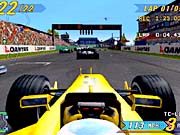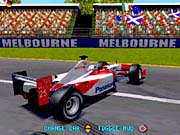Every level of F1 enthusiast can play and enjoy Grand Prix Challenge. Infogrames Melbourne House has designed the game in such a way that it can be set up to play like an off-the-cuff, arcade-style racing game or can be adjusted by varying degrees to simulate the actual physics and handling of an unforgiving F1 racing vehicle.

When you select the beginner and intermediate settings, Grand Prix Challenge isn't much different from other F1 games. On the easiest setting, the traction control and automatic braking systems prevent you from spinning out under all but the most harrowing of circumstances. Set to intermediate, automatic braking is disabled, so you need to lower your speed going into corners in order to avoid spinouts. You also have the option to toggle the traction control to provide high or low tire grip depending on the situation.
The expert setting is very challenging, but it's also how Grand Prix Challenge differentiates itself from other F1 games. In addition to the choice of manual or automatic transmission, you have three levels of traction control that you can vary throughout the race. The high setting lets you make a standing start without sliding into a spin, while the low setting helps you handle moderate turns. In straights, you can disable the traction control system in order to maximize your speed, but your car will spin out if you so much as nip a rumble strip or a patch of grass. On expert, you have to figure out the most appropriate TCS settings for each section of the course, in addition to jockeying for position with the other drivers and navigating the track itself. The expert setting also emphasizes just how realistic the game's handling truly is. In a tight turn, you can induce a slight spinout in order to swing the car's back end around the curve. From a standing start in wet weather, the spray kicked up by the cars in front of you can land in front of your tires and make it difficult to accelerate forward. The sheer number of subtle details you have to account for is daunting, but it's impressive in the respect that most F1 games don't try this hard to simulate everything that occurs on a high-speed racetrack.
You can turn damage and fuel consumption on or off in the setup menu. In addition, you also have the option to adhere to the official rules that apply to F1A-sanctioned races. This includes flags and penalties for reckless driving or taking shortcuts on the course, as well as the flags that go up whenever an accident occurs or when you're about to be lapped by another car. In later laps, an accident can leave you stuck with a midpack finish, since you can't overtake vehicles until the green flag appears.
Considering how detailed it is in most aspects, it's surprising that Grand Prix Challenge doesn't let you configure cars to the extent that similar games usually do. In the setup menu, you can adjust sliders that influence tire type, downforce, gearbox ratios, suspension, and brake balance, but not to such a degree that you can choose specific settings for the front and rear portions of the vehicle. Similarly, you don't have much control over what occurs during a pit stop. Fuel levels and damage are taken care of automatically. The only input you have is whether or not you want to play a timing-based minigame in order to put pressure on your pit crew to work faster.
Provided you're not hung up on tweaking cars to death, Grand Prix Challenge offers a fair amount of variety. It includes 11 official F1 racing teams, 22 drivers, and 17 of the actual venues used in the 2002 racing season. Play options include quick race, time trial, championship, and a two-player split-screen mode. In the championship mode, you can participate in practice, qualifying, and warm-up runs before the main race. The most interesting play mode is the grand prix challenge, where you compete in a series of 10 events that become progressively more difficult as you win each successive competition. The first challenge consists of five laps on two separate courses against easy opponents. If you make it to the final event, you'll race against tough opponents on a series of courses in wet weather.
Like the subtleties you can experience while playing the game, the visuals in Grand Prix Challenge display a nice amount of detail. All of the hills and chicanes found in actual race venues are present. The game is capable of rendering 22 cars onscreen at once, complete with smoke trails, steaming exhaust, and spinning tires. On wet tracks, water droplets kick up in small, lofting clouds. Patches of rubber left along the asphalt, as well as tracks ground into the turf, remain visible throughout the duration of the race. One particularly neat aspect is that the spectators in the stands show a lot of life. They wave flags, take flash pictures, and set off smoke bombs to show their support. Despite this abundance of detail, the overall frame rate remains steady, even when you're among a pack of vehicles. The only significant drawback to the visuals is that they exhibit the same sort of coarseness prevalent in many racing games that are available for the PS2. The graphics aren't as jagged as those in Ridge Racer V, but they're not nearly as crisp as those in Gran Turismo 3 either.

The audio exhibits a high level of quality as well. In addition to the usual assortment of engines and tire squeals that you've come to expect from racing games, the course environment has its own fair share of atmosphere. You can hear the rotors of helicopters observing the race, and the crowd expresses audible "oohs" and "aahs" every time you nudge a rail or participate in an accident. In order to elevate the excitement level a bit, loud European-style techno and trance music provides the undercurrent for each race. If you're a stickler for realism, you can adjust the volume of the music in the options menu.
Grand Prix Challenge is one of those rare racing games that can actually be enjoyed by beginner and expert alike. Its only significant shortcomings are that you can't tune the cars to the same extent that you can in traditional simulations and that there isn't a scenario or franchise mode to appeal to devout followers of the F1 racing season.